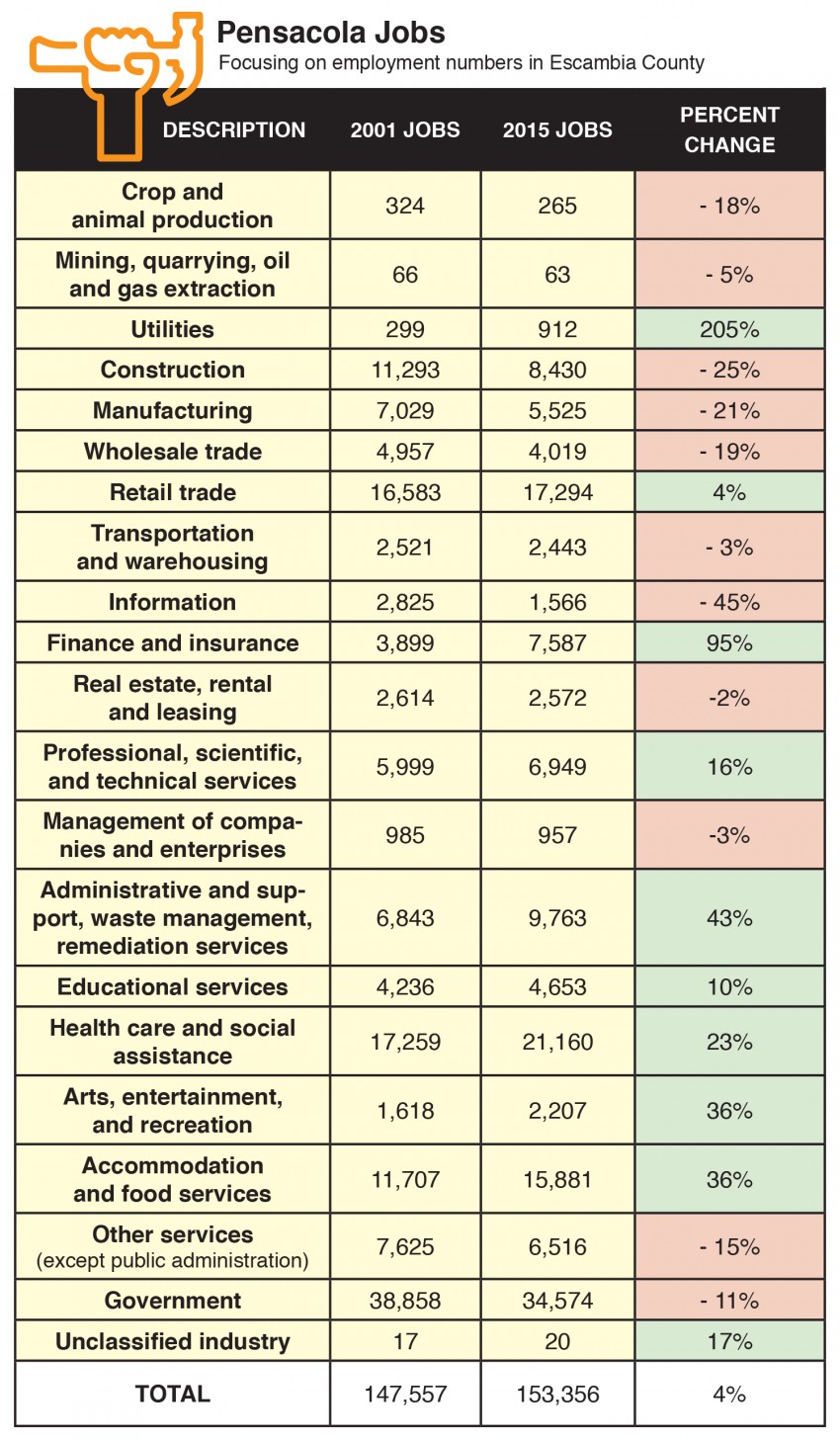Economic uncertainty filters through Pensacola, state
- September 12, 2016
- / Shannon Nickinson
- / economy

Cover of the 2016 Pensacola Young Professionals Quality of Life survey.
So that feeling many people have that better economic times aren’t coming to them has at least one foot in reality.
The 13th edition of State of Working Florida was released Sept. 12 by Florida International University.
Among the 2016 State of Working Florida’s key findings:
— As of 2014, the average upper class household earns three times what the average middle class household earns and nearly 10 times what the average working class family earns.
— The decline in household incomes experience by the working class led to increased poverty rates among every demographic between 2009 and 2014.
— In 2014, the five main occupations of higher wage and salary earners are management, healthcare practitioners and technical jobs, sales and related jobs, business and financial operations, and computer and math occupations.
— The five main occupations of middle wage and salary workers are office and administrative support, sales and related occupations, management, education training, and library, and transportation and material moving jobs.
— The five main occupations of lower wage and salary earners are sales and related occupations, food preparative and service jobs, office and administrative support, building and ground cleaning and maintenance jobs, and transportation and material moving jobs.
— Women earn $0.78 for every $1 made by men, when controlling for age, education, and occupation.
— Racial and ethnic minorities earn $0.92 for every $1 made by whites, also controlling for age, education, and occupation.
— Policy recommendations include: paying higher wages to low-wage workers, stopping workplace discrimination, and improving educational outcomes, especially in college graduation rates.
From 2009 to 2014, the share of working, middle and upper class households was essentially flat in Florida — about 30 percent working class; about 50 percent middle class, about 20 percent upper class.
“The research finds that the economic polarization of classes in Florida is largely a reflection of an occupational structure offering fewer middle income jobs that facilitate upward mobility,” the study says.
“Many working Floridians continue to be perpetually stuck in low-wage occupations while occupations that have historically facilitated upward economic mobility have eroded,” it says. “At the same time, recent growth in occupations with high education and/or skill requirements have provided some with the opportunity to achieve high incomes.”
The Pensacola Young Professionals 2016 Quality of Life survey released last week, reflects a similar ambivalence.
Some 72 percent of respondents rated Escambia County’s economic status as poor or fair; 28 percent rated it good or excellent.
And 54 percent of those surveyed expects the same thing to be true five years from now.
At the media roll out for the survey Jon Pytynia, PYP’s vice president of community development, noted that the survey captures perception. And that perception is — for better or worse — the reality with which our community leaders must deal.
Improving the quality of life in this community means dealing with the challenges that educational attainment, wages and economic opportunity present our citizens.
Jobs and the economy remain citizens top concern. As has been the case since 2008, jobs and economic prospects remain the key area of concern for those surveyed.
This year, 28 percent of those surveyed called the county’s economic prospects good or excellent; 72 percent said fair or poor.
In 2008, only 14 percent said economic prospects were good or excellent, and 86 percent said fair or poor.
Job security concerns also remain high on people’s minds — 53 percent are somewhat or very concerned about the future of their own job or a family member’s job. It was 59 percent in 2008.
The survey asked 800 residents of the county their opinions and attitudes about several aspects of the community, including their perception of elected officials in the city and county, the economy and quality of life in the area. It began in 2008.
This year, the survey was done the week of June 22-28, and includes registered voters reachable by landline and cell phone numbers. Mason Dixon polling, which conducted the survey, achieved a sample that reflects the demographic, geographic, educational and working status of the county at large.
PYP releases the results and manages the survey. Quint and Rishy Studer fund the survey every year. PYP notes that Mason-Dixon was paid $28,500 this year. Design and printing of the survey by Pensacola firm Emagination will range between $8,000 and $12,000 depending on services requested, PYP says. The Studers are also the founders and key funders of the Studer Community Institute.
Where has the job growth been in the area in the last 14 years?

Based on U.S. Census data, a look at where jobs have grown and shrunk in the Pensacola area's economy from 2001 to 2015.
Building on these emerging strengths, and investing in the educational outcomes that can help all of our citizens meet their potential, is the most important work our community can do.
Let’s get to work on it.
 CivicCon launches with a look at good growth in cities
CivicCon launches with a look at good growth in cities
 Building stronger brains one baby, one parent at a time
Building stronger brains one baby, one parent at a time
 SCI debuts commercial on Early Learning City
SCI debuts commercial on Early Learning City
 Entrecon: World class speakers and an opportunity to sharpen skills
Entrecon: World class speakers and an opportunity to sharpen skills
 PYP Quality of Life survey 2017
PYP Quality of Life survey 2017
 EntreCon Pensacola 2016: A look back
EntreCon Pensacola 2016: A look back
 Leadership tip: getting better employee takeaways
Leadership tip: getting better employee takeaways
 Leadership tip: be interested instead of interesting
Leadership tip: be interested instead of interesting
 Leadership tip: delivering difficult messages
Leadership tip: delivering difficult messages
 Brain Bags boost Arc, Early Childhood Court programs
Brain Bags boost Arc, Early Childhood Court programs